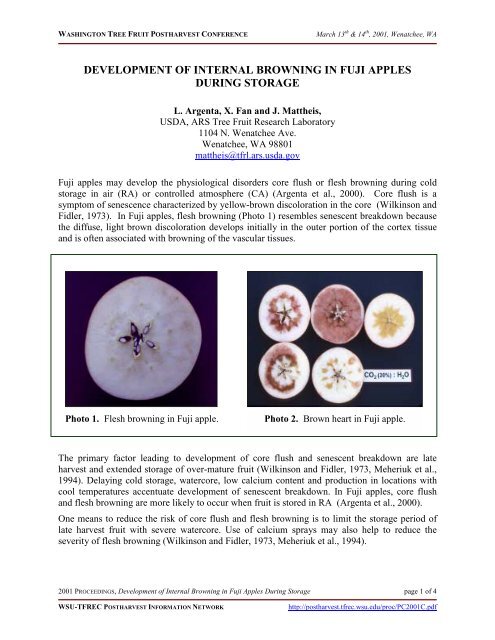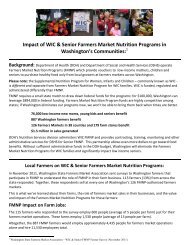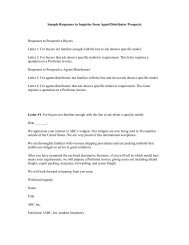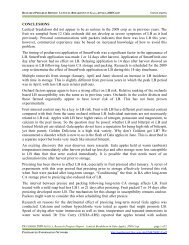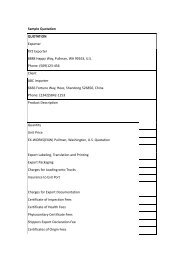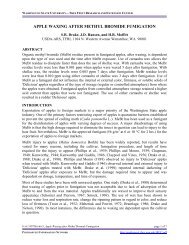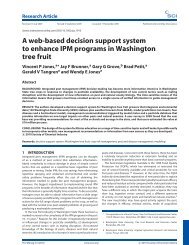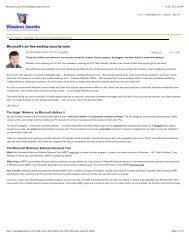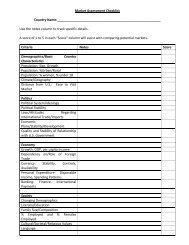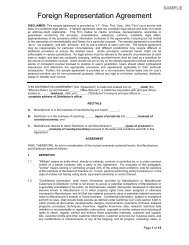Development of Internal Browning in Fuji Apples During Storage
Development of Internal Browning in Fuji Apples During Storage
Development of Internal Browning in Fuji Apples During Storage
Create successful ePaper yourself
Turn your PDF publications into a flip-book with our unique Google optimized e-Paper software.
WASHINGTON TREE FRUIT POSTHARVEST CONFERENCEMarch 13 th & 14 th , 2001, Wenatchee, WADEVELOPMENT OF INTERNAL BROWNING IN FUJI APPLESDURING STORAGEL. Argenta, X. Fan and J. Mattheis,USDA, ARS Tree Fruit Research Laboratory1104 N. Wenatchee Ave.Wenatchee, WA 98801mattheis@tfrl.ars.usda.gov<strong>Fuji</strong> apples may develop the physiological disorders core flush or flesh brown<strong>in</strong>g dur<strong>in</strong>g coldstorage <strong>in</strong> air (RA) or controlled atmosphere (CA) (Argenta et al., 2000). Core flush is asymptom <strong>of</strong> senescence characterized by yellow-brown discoloration <strong>in</strong> the core (Wilk<strong>in</strong>son andFidler, 1973). In <strong>Fuji</strong> apples, flesh brown<strong>in</strong>g (Photo 1) resembles senescent breakdown becausethe diffuse, light brown discoloration develops <strong>in</strong>itially <strong>in</strong> the outer portion <strong>of</strong> the cortex tissueand is <strong>of</strong>ten associated with brown<strong>in</strong>g <strong>of</strong> the vascular tissues.Photo 1. Flesh brown<strong>in</strong>g <strong>in</strong> <strong>Fuji</strong> apple.Photo 2. Brown heart <strong>in</strong> <strong>Fuji</strong> apple.The primary factor lead<strong>in</strong>g to development <strong>of</strong> core flush and senescent breakdown are lateharvest and extended storage <strong>of</strong> over-mature fruit (Wilk<strong>in</strong>son and Fidler, 1973, Meheriuk et al.,1994). Delay<strong>in</strong>g cold storage, watercore, low calcium content and production <strong>in</strong> locations withcool temperatures accentuate development <strong>of</strong> senescent breakdown. In <strong>Fuji</strong> apples, core flushand flesh brown<strong>in</strong>g are more likely to occur when fruit is stored <strong>in</strong> RA (Argenta et al., 2000).One means to reduce the risk <strong>of</strong> core flush and flesh brown<strong>in</strong>g is to limit the storage period <strong>of</strong>late harvest fruit with severe watercore. Use <strong>of</strong> calcium sprays may also help to reduce theseverity <strong>of</strong> flesh brown<strong>in</strong>g (Wilk<strong>in</strong>son and Fidler, 1973, Meheriuk et al., 1994).2001 PROCEEDINGS, <strong>Development</strong> <strong>of</strong> <strong>Internal</strong> <strong>Brown<strong>in</strong>g</strong> <strong>in</strong> <strong>Fuji</strong> <strong>Apples</strong> Dur<strong>in</strong>g <strong>Storage</strong> page 1 <strong>of</strong> 4WSU-TFREC POSTHARVEST INFORMATION NETWORKhttp://postharvest.tfrec.wsu.edu/proc/PC2001C.pdf
WASHINGTON TREE FRUIT POSTHARVEST CONFERENCEMarch 13 th & 14 th , 2001, Wenatchee, WA<strong>Fuji</strong> apples are also susceptible to brownheart(<strong>in</strong>ternal dark brown<strong>in</strong>g) dur<strong>in</strong>g CAstorage (Photos 2 and 3). This is a CO 2 -<strong>in</strong>duced disorder as it is exacerbated by highCO 2 concentrations <strong>in</strong> air or CA storage(Argenta et al., 2001).Some factors contribut<strong>in</strong>g to greater<strong>in</strong>cidence and severity <strong>of</strong> brown-heart <strong>in</strong><strong>Fuji</strong> (Argenta et al., 2001) and Braeburn(Elgar et al., 1999) apples are: harvest atadvanced maturity, presence <strong>of</strong> severewatercore, light crop load and production <strong>in</strong>colder regions or seasons and higher altitudedistricts with<strong>in</strong> a region. The susceptibility<strong>of</strong> <strong>Fuji</strong> and Braeburn apples to CO 2 -<strong>in</strong>jury ishighest dur<strong>in</strong>g the first weeks <strong>of</strong> RA or CAstorage after harvest.Photo 3. Brown heart (CO 2 <strong>in</strong>jury) <strong>in</strong> <strong>Fuji</strong>.Fruit were exposed 9 days to 10% O 2 + 20%CO 2 at 68 ºF. Top two rows <strong>of</strong> fruit treatedwith diphenylam<strong>in</strong>e (DPA) at 2000 ppm.Postharvest treatment with diphenylam<strong>in</strong>e (DPA) effectively prevents the development <strong>of</strong> CO 2 -<strong>in</strong>jury <strong>in</strong> <strong>Fuji</strong> apples (Photo 3). However, restrictions on postharvest chemical use for somemarkets have spurred research to develop alternative non-chemical procedures for prevention <strong>of</strong>CO 2 -<strong>in</strong>jury. There are both production and postharvest practices that can reduce thedevelopment <strong>of</strong> CO 2 <strong>in</strong>jury. Crop load management and m<strong>in</strong>imal use <strong>of</strong> nitrogen fertilizer canallow fruit to be harvested earlier with good red and break<strong>in</strong>g background colors and with am<strong>in</strong>imum <strong>of</strong> watercore. Delay<strong>in</strong>g CA (1 to 1.5% O 2 , 0.5 to 1% CO 2 ) or CO 2 accumulation dur<strong>in</strong>gCA reduces the <strong>in</strong>cidence <strong>of</strong> CO 2 -<strong>in</strong>jury. The CA- and CO 2 -delay procedures can result <strong>in</strong> someloss <strong>of</strong> firmness (0.5 to 1 lb) and acidity (0.02% to 0.05%) compared with rapid CA; howeverquality loss is not sufficient to negate the benefits <strong>of</strong> CA compared with RA storage. The period<strong>of</strong> CO 2 delay required for effective reduction <strong>of</strong> CO 2 -<strong>in</strong>jury may vary (1 to 3 months) depend<strong>in</strong>gon the season. The CA or CO 2 delay shouldbe as short as possible to preserve thebeneficial effects <strong>of</strong> CA on fruit quality.Fruit should still be cooled promptly afterharvest. For <strong>Fuji</strong> apples harvested with goodmaturity (starch 3 to 4, slight to moderatewatercore), a delay <strong>of</strong> CA for 10 to 14 daysafter harvest or a delay <strong>of</strong> CO 2 accumulationfor one month after harvest is advised. Ifharvested at advanced maturity (starch <strong>in</strong>dexhigher than 5) and severely watercored(scored higher than 3, Photo 4) fruit shouldbe stored <strong>in</strong> CA only if it is delayed for atPhoto 4. Watercore scores for <strong>Fuji</strong> apple.least 4 weeks or if CO 2 is held below 0.5%dur<strong>in</strong>g first 2 months after harvest.The ethylene action <strong>in</strong>hibitor 1-MCP effectively reduces firmness and titratable acidity loss <strong>in</strong><strong>Fuji</strong> apples dur<strong>in</strong>g RA or CA storage. The objective <strong>of</strong> the present study was to determ<strong>in</strong>e the2001 PROCEEDINGS, <strong>Development</strong> <strong>of</strong> <strong>Internal</strong> <strong>Brown<strong>in</strong>g</strong> <strong>in</strong> <strong>Fuji</strong> <strong>Apples</strong> Dur<strong>in</strong>g <strong>Storage</strong> page 2 <strong>of</strong> 4WSU-TFREC POSTHARVEST INFORMATION NETWORKhttp://postharvest.tfrec.wsu.edu/proc/PC2001C.pdf
WASHINGTON TREE FRUIT POSTHARVEST CONFERENCEMarch 13 th & 14 th , 2001, Wenatchee, WA<strong>in</strong>teractive effects <strong>of</strong> 1-MCP treatment and delay<strong>in</strong>g CA establishment or CO 2 accumulationdur<strong>in</strong>g CA on development <strong>of</strong> CO 2 -<strong>in</strong>jury and preservation <strong>of</strong> fruit quality.<strong>Fuji</strong> apples harvested from a commercial orchard <strong>in</strong> north central Wash<strong>in</strong>gton one week afteroptimum maturity for long-term storage were cooled to 33 ºF with<strong>in</strong> 24 hr <strong>of</strong> harvest and thenstored <strong>in</strong> RA or <strong>in</strong> CA at 1.5% O 2 + 0.05% CO 2 or 1.5% O 2 + 3% CO 2 for 8 months. We used3% CO 2 to <strong>in</strong>crease the risk <strong>of</strong> develop<strong>in</strong>g <strong>in</strong>jury but do not recommend this concentration forcommercial storage. CA treatments/conditions were established as follows:• Rapid CA: CA conditions (1.5 % O2 + 3 % CO2) were established with<strong>in</strong> 72 hr <strong>of</strong>harvest.• CA delay: Fruit were held <strong>in</strong> RA for 2, 4 or 6 weeks after harvest, then CA (1.5% O 2+ 3% CO 2 ) was established and ma<strong>in</strong>ta<strong>in</strong>ed for the rema<strong>in</strong>der <strong>of</strong> the storage period.• CO 2 delay: fruit were stored <strong>in</strong> 1.5% O 2 + 0.05% CO 2 for 1, 2 or 3 months afterharvest, then CO 2 was <strong>in</strong>creased to 3% for the rema<strong>in</strong>der <strong>of</strong> the storage period.Fruit were treated with 1 ppm MCP for 24 hours at 33 ºF at harvest or dur<strong>in</strong>g storage; i.e., fruitstored us<strong>in</strong>g a CA delay were treated with 1 ppm MCP 2, 4 or 6 weeks after harvest while fruitstored us<strong>in</strong>g a CO 2 delay were treated with 1 ppm MCP 1, 2 or 3 months after harvest.Results <strong>in</strong>dicated that both CA conditions and 1-MCP treatment improved ma<strong>in</strong>tenance <strong>of</strong>firmness and titratable acidity and reduced <strong>in</strong>cidence <strong>of</strong> scald and core brown<strong>in</strong>g dur<strong>in</strong>g longtermstorage compared with untreated fruit stored <strong>in</strong> air.Previous results (1998) <strong>in</strong>dicated 1-MCP-treated <strong>Fuji</strong> apples stored <strong>in</strong> RA had higher firmnessand titratable acidity than control fruit stored <strong>in</strong> CA with low (0.05%) CO 2 after 6 months. The1999 results showed 1-MCP treatment was as effective as CA storage for preservation <strong>of</strong>firmness but less effective then CA storage for preservation <strong>of</strong> acidity after 8 months storage. Inboth years, treatment with 1-MCP did not provide enhanced preservation <strong>of</strong> firmness or titratableacidity for fruit stored <strong>in</strong> CA with 3% CO 2 .CA- and CO 2 -delay procedures effectively reduce severity <strong>of</strong> CO 2 -<strong>in</strong>jury (brown-heart)regardless <strong>of</strong> 1-MCP treatment. There are no significant impacts <strong>of</strong> 1-MCP treatment ondevelopment <strong>of</strong> CO 2 -<strong>in</strong>jury <strong>in</strong> RA- or rapid CA-stored fruit. However, CA- and CO 2 -delayprocedures are less effective on prevention <strong>of</strong> CO 2 -<strong>in</strong>jury for fruit treated with 1-MCP at harvestcompared with untreated fruit, <strong>in</strong>dicat<strong>in</strong>g that 1-MCP treatment extends the period after harvestwhen <strong>Fuji</strong> apples are susceptible to CO 2 -<strong>in</strong>jury (brown-heart).Similarly, there are no significant impacts <strong>of</strong> 1-MCP treatment on dissipation <strong>of</strong> watercore <strong>in</strong>RA- and rapid CA-stored fruit. However, for fruit stored <strong>in</strong> CA- or CO 2 -delayed conditions,1-MCP slows watercore dissipation compared with untreated fruit.For CA-stored fruit, delay<strong>in</strong>g 1-MCP treatment after harvest results <strong>in</strong> less development <strong>of</strong> CO 2 -<strong>in</strong>jury compared with 1-MCP treatment at harvest. However, delay<strong>in</strong>g 1-MCP treatment afterharvest is less effective for reduc<strong>in</strong>g firmness and titratable acidity loss compared with 1-MCPtreatment at harvest.2001 PROCEEDINGS, <strong>Development</strong> <strong>of</strong> <strong>Internal</strong> <strong>Brown<strong>in</strong>g</strong> <strong>in</strong> <strong>Fuji</strong> <strong>Apples</strong> Dur<strong>in</strong>g <strong>Storage</strong> page 3 <strong>of</strong> 4WSU-TFREC POSTHARVEST INFORMATION NETWORKhttp://postharvest.tfrec.wsu.edu/proc/PC2001C.pdf
WASHINGTON TREE FRUIT POSTHARVEST CONFERENCEMarch 13 th & 14 th , 2001, Wenatchee, WAIn conclusion, maximum retention <strong>of</strong> firmness and acidity with m<strong>in</strong>imum development <strong>of</strong>brown-heart occurs when <strong>Fuji</strong> apples are stored <strong>in</strong> CA delayed for 4 or 6 weeks after harvest or<strong>in</strong> CA with CO 2 accumulation delayed for 1 month after harvest or <strong>in</strong> 1-MCP-treated fruit stored<strong>in</strong> RA or CA with low (0.05%) CO 2 .ACKNOWLEDGEMENTSTechnical assistance <strong>of</strong> David Buchanan and Janie Countryman is gratefully acknowledged. Wethank the Wash<strong>in</strong>gton State Tree Fruit Research Commission for provid<strong>in</strong>g funds to support thisresearch.REFERENCESArgenta, L.C., Fan, X., Mattheis, J.P., 2000. Delay<strong>in</strong>g establishment <strong>of</strong> controlled atmosphere orCO2 exposure reduces <strong>Fuji</strong> apple CO2 <strong>in</strong>jury without excessive fruit quality loss. PostharvestBiology and Technology 20, 221-229.Argenta, L.C., Fan, X., Mattheis, J.P., 2001. Responses <strong>of</strong> <strong>Fuji</strong> <strong>Apples</strong> to Short and LongDuration Exposure to Elevated CO 2 Concentration. Postharvest Biology and Technology. Inpress.Elgar, J.H., Burmeister, D.M., Wark<strong>in</strong>s, C.B., 1998. <strong>Storage</strong> and handl<strong>in</strong>g effects on a CO 2 -related <strong>in</strong>ternal brown<strong>in</strong>g disorder <strong>of</strong> Braeburn apples. HortScience, 33, 719-722.Meheriuk, M., Prange, R.K. Lidster, P.D., Porritt, S.W., 1994. Postharvest disorders <strong>of</strong> applesand pears. Agriculture Canada Publication 1737E. Communications Branch, AgricultureCanada Ottawa, Ont. 66p.Wilk<strong>in</strong>son, B.G., Fidler, J.C., 1973. Physiological disorders. In: Fidler, J.C., Wilk<strong>in</strong>son, B.G.,Edney, K.L., Sharples, R.O (ed), The biology <strong>of</strong> apple and pear storage. Research Review no.3, Commonwealth Bureau <strong>of</strong> Horticulture and Plantation Crops, East Mall<strong>in</strong>g, UK,pp. 65-131.2001 PROCEEDINGS, <strong>Development</strong> <strong>of</strong> <strong>Internal</strong> <strong>Brown<strong>in</strong>g</strong> <strong>in</strong> <strong>Fuji</strong> <strong>Apples</strong> Dur<strong>in</strong>g <strong>Storage</strong> page 4 <strong>of</strong> 4WSU-TFREC POSTHARVEST INFORMATION NETWORKhttp://postharvest.tfrec.wsu.edu/proc/PC2001C.pdf


